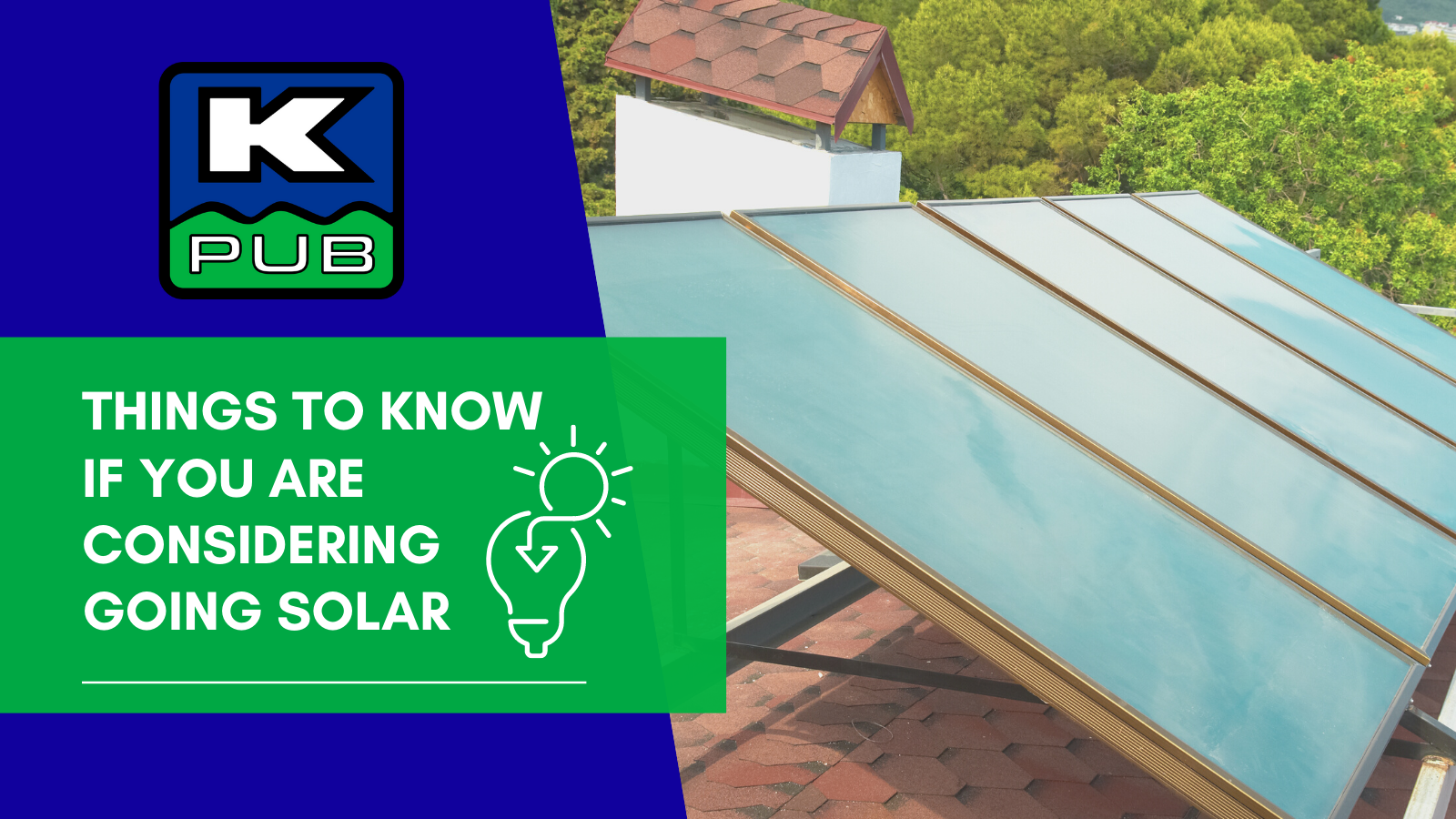
At Kerrville Public Utility Board (KPUB), we recognize that different customers have different priorities for their electric service, and we strive to provide options for everyone.
Did you know that as a KPUB customer, you are already using renewable energy? We purchase power from diverse, competitive sources to ensure the best possible rates when keeping the lights on for our community and to meet our customers’ needs.
As your community-owned, not-for-profit electric utility company, KPUB is here to be your source for your energy investment decisions and information.
We’re here to help you ask the right questions and help you determine if going solar is the right investment for you.
Is Distributed Generation (DG) Right for Me?
Distributed Generation (DG) refers to small-scale power generation (i.e. solar, wind, other) at a customer’s home, or business, used to reduce the customer’s need for power from the utility power grid.
It is important to research the facts before committing to a solar system purchase and explore whether solar is the right investment.
Steps to Take Before Installing DG
Do Your Research & Review Upfront Costs Before You Invest
Please note that while KPUB does not sell, install or maintain solar systems, we should still be one of your first contacts when considering a solar system investment.
Contact our engineering department at 830.257.3050 today for a free review of your DG system proposal.
Solar systems are purchased through a contractor, and you will be the owner and the party responsible for the purchase price and ongoing maintenance and repair costs. If leasing is an option you prefer, you will pay less initially, but you’ll likely have higher long-term expenses. Whichever option you choose (purchasing vs. leasing), it is very beneficial to do your research on all of the costs that you will be responsible for during the life of the system. Examples of those expenses are: installation (in addition to the price of the system), interconnection costs, insurance, taxes, etc.
If you are considering leasing, ask important questions like the length of the lease term, if the contract is transferrable to a new homeowner should you sell your home and the potential for price increases.
Choose a Reputable Contractor/Installer
KPUB does not make recommendations or endorsements for specific contractors/solar companies. However, we do realize the importance of finding a reputable installer who will size the system properly. Please do your research, ask for local customer references, pictures of previous customers’ installations and check consumer reviews online before you submit any payment or sign any agreements.
Review Your Current Energy Usage to Help Determine an Appropriate Solar System Size
Understanding your electricity usage and overall energy needs is an important step in the process of investigating whether a DG system is a good investment for you. Through your free KPUB SmartHub account, you have the ability to review and analyze your prior energy usage and how that usage fluctuates each calendar year. That data will help you determine the size and system that best fits your home energy consumption trends.
The biggest financial bang for your buck will be achieved by primarily offsetting usage inside your home and limiting your exports to the grid. KPUB’s residential rates have three components: a $10.25 monthly customer charge, distribution charges of about 2 cents per kWh, and power supply costs of about 6.5 cents kWh. When you offset usage in your home, you avoid both the distribution charge and the power supply charge (about 8.5 cents per kWh total). When you deliver to the grid, you get a credit for only the power supply charge.
Additionally, complete a thorough energy efficiency audit. In many cases, it is more beneficial to upgrade your home’s efficiency measures prior to installing a distributed generation resource in order to reduce your energy bill. Generally, you want your home to be as efficient as possible and then investigate solar power options.
Research Potential Incentives and Tax Credits
It’s important to know what types of financial incentives are available to offset your investment costs. Incentives often are driven by laws or policies; have expiration dates; and can vary by type and size of the system, whether it’s for residential or commercial/industrial use, and other factors.
The Database of State Incentives for Renewables & Efficiency (www.dsireusa.org) is one source of information on incentives and policies that support renewables and energy efficiency in the U.S. The site features an interactive map, which allows users to click on a state to see a comprehensive listing of federal and state incentives, credits, exemptions, grants, loans and rebates for residential and commercial/industrial projects and programs.
KPUB has various rebates for energy efficiency improvements, but we do not have rebates for the installation of distributed generation.
Understand How a Solar System Interconnects with KPUB’s System
Most solar systems are designed to provide you with a portion of the electricity required but may not provide 100 percent of your needs. You’ll most likely still need power from a centralized energy grid, so it’s important to realize that DG is intended for supplemental power to meet your own energy needs. At night, on cloudy days, and possibly during other high-energy-use times, you’ll need more power than your solar system can produce.
That means you’ll still be connected to KPUB’s power lines. Because those systems are grid-connected, energy can flow both ways. Each utility—including KPUB—sets appropriate policies and rates for connecting solar systems to our lines (the grid).
Requirements to Interconnect your DG System with KPUB
Before installing a DG system, please review the requirements and documentation that must be submitted for approval in order to “interconnect” with the electrical supply provided by the Kerrville Public Utility Board (KPUB). Details can be found online here.
Other FAQ for Going Solar
If I install solar, will I still have a KPUB bill?
Yes, you will. Even if you install a system that produces all of the energy that you need on a monthly basis, there will always be charges and credits like the monthly customer service charge, charges for energy consumed at night (for solar), and credits for the energy you deliver to the grid.
Dose KPUB buy back any excess solar that’s produced?
Yes. Your KPUB bill will show two different energy totals: the total amount of energy delivered by KPUB to your home and the total amount of energy you delivered to the KPUB grid. For the total amount of energy delivered by KPUB to your home there will be a charge for the distribution and power supply costs. For the total amount of energy you deliver to the KPUB grid, there will be a credit for the power supply component of our rates. When a distributed generation installation is approved, we install a specially programmed meter that keeps track of the two different amounts separately.
Any excess electrical output of your DG system will appear as a bill credit at the rates in accordance with the terms of, KPUB’s then approved Tariff for Electric Service, Rider DG – Distributed Generation.
Do you still have questions? We are happy to help! Contact our engineering department at 830.257.3050 today.
